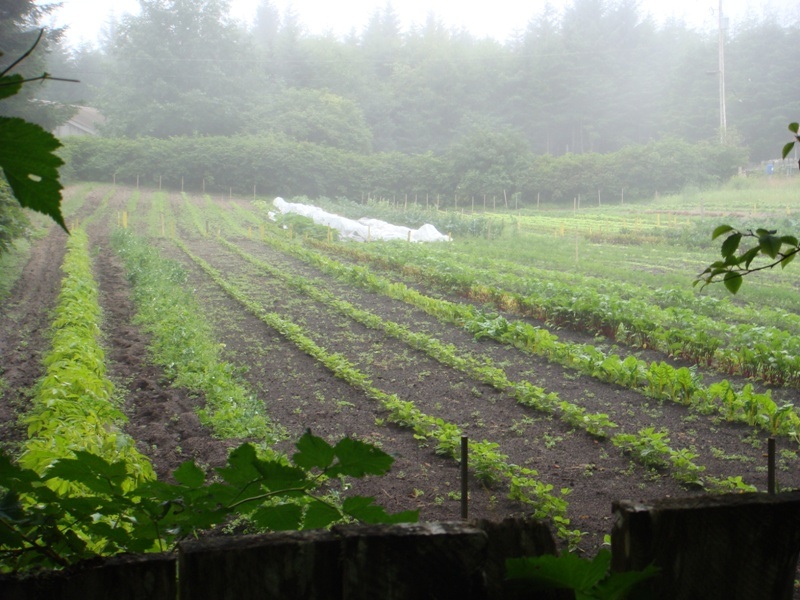A remote group of islands just south of the Alaskan panhandle and 100 km off the northern coast of British Columbia seems an unlikely location for Farm to Cafeteria – yet an amazing cluster of programs flourish there. Farm to School, and Farm to Hospital programs seeded in the fall of 2010 are taking root in Haida Gwaii thanks to start up fnding from the Produce Availability Initiative. Great strides have been made to realize a common vision – a strong, sustainable island food system.
Equipped with funds earmarked for redesigning school kitchens and dining areas, building gardens and greenhouses, and purchasing school and farm equipment – this island community has established and linked 3 different farms with 8 different public agencies.
Three Farms
Three farms provide foods to local hospitals, health care centres, and schools – Riverworks Farm, Sangan River Farm and the Lavoie Family Farm. Each is unique with respect to their history, their size, their methods of food production, and their reasons for being involved. Sangan River Farm is a small newer operation of a few acres, and the owner prefers to provide foods in small increments matching the schools food needs with his capacity to grow. Riverworks Farm is a mid sized permaculture farm that has been in operation for more than 2 decades. Farmer, Bill McKay is able to supply large quantities of organic food and is looking for a larger market. The Lavoie Family Farm is owned and operated by the close knit Mennonite community. The Lavoie family is making their local food available all over the island including at grocery stores, restaurants, road side stalls and the Farm to School Program. All farmers readily assert that they are not simply growing food for profit, they are engaged because they want to grow a new generation of farmers and to create an island that is food self-sufficient.
Five Greenhouses
No less than five greenhouses are in various stages of development on the island – two on farms, one at an elder’s centre and two in the schoolyard (one elementary and one secondary school. While each is designed (in part) to produce foods for Farm to Cafeteria programs, each has a strong emphasis on retaining or enhancing skills and knowledge about local and/or traditional foods and the ways to produce, harvest, and preserve those foods. While George M. Dawson Secondary has completely renovated their kitchen and they have integrated their F2C meal service into home economic classes, the greenhouse is viewed as a the centre piece of the Farm to cafeteria program – equal to the meal service. Teachers have integrated greenhouse activities into science, math, English and arts curriculum.
Seven Schools
One hundred percent of schools in Haida Gwaii have established a version of the farm to Cafeteria programs including – Port Clements Elementary School in Port Clements, George M. Dawson Secondary in Masset, Queen Charlotte Secondary School in Queen Charoltte, Chief Mathews Elementary School in Old Masset, Sk’Aagdaa Naay Elementary School in Skidegate, ALM Elentary Junior Secondary School in Sandspit and Tahayghen Elementary School in Masset. Each of these programs is unique in the way food is delivered from the farm to the fork, and/or in their meal service. Sk’Aagdaa Naay Elementary, Queen Charoltte Secondary, Port Clements Elementary and George M Dawson Secondary have established a direct relationship with a farmer. Each school purchases a box a week of foods from the farmer (whatever is available and in season). Menus are built around the foods that are available. Port Clements offers a soup and sandwich lunch and George M Dawson offers a full soup and salad bar service plus a hot entrée. Chief Mathews Elementary and Tahayghen Elementary receive hot entrees and fresh salads from a culinary arts program run by Old Masset Village Office A box of local foods is delivered to the culinary arts program once a week from two farms. Once at the school the food is dished out by teachers or student volunteers.
One Hospital
Northern Health’s Haida Gwaii Hospital orders a $40.00 box of produce each week from 2 island farms. Boc choy, squash onion, and even salad greens arrive at the hospital year round. These foods are sliced, diced, and sauteed and then worked into the core menu. The result? Savoury soups and crispy salads add vibrant colours, tantalizing smells and a new crunch to patient lunch.
Haida Gwaii: Farm to Cafeteria Firsts
One of the first clusters of Farm to Cafeteria programs that have placed equal emphasis on the redesign of the regional food system, AND the redesign of institutional food systems AND the sharing/building of community skills and knowledge in the process.
One of the first clusters of Farm to Cafeteria programs to receive funding earmarked for the purchase of farm equipment shared between farmers for the production of foods for local schools and hospitals.
One of the first School Districts to sign a Memorandum of Agreement with a farming organization to support Farm to Cafeteria programs and the sharing of resources for this purpose.
One of the first programs in BC where local foods from farms are delivered to schools by school bus.
One of the first Farm to Hospital programs in British Columbia integrating local food into patient meals.
One of the first programs where the central kitchen is an aboriginal culinary arts program located on reserve, and the schools that receive the foods are located both on reserve and off.
Finally, one of the first communities that has seen the creation of a food security funding stream from the local aboriginal funding agency – Gwaii Trust. The whirlwind of Farm to Cafeteria activity has undoubtedly been a factor in this development.
Contact
Shelly Crack
Community Nutritionist, Northern Health





